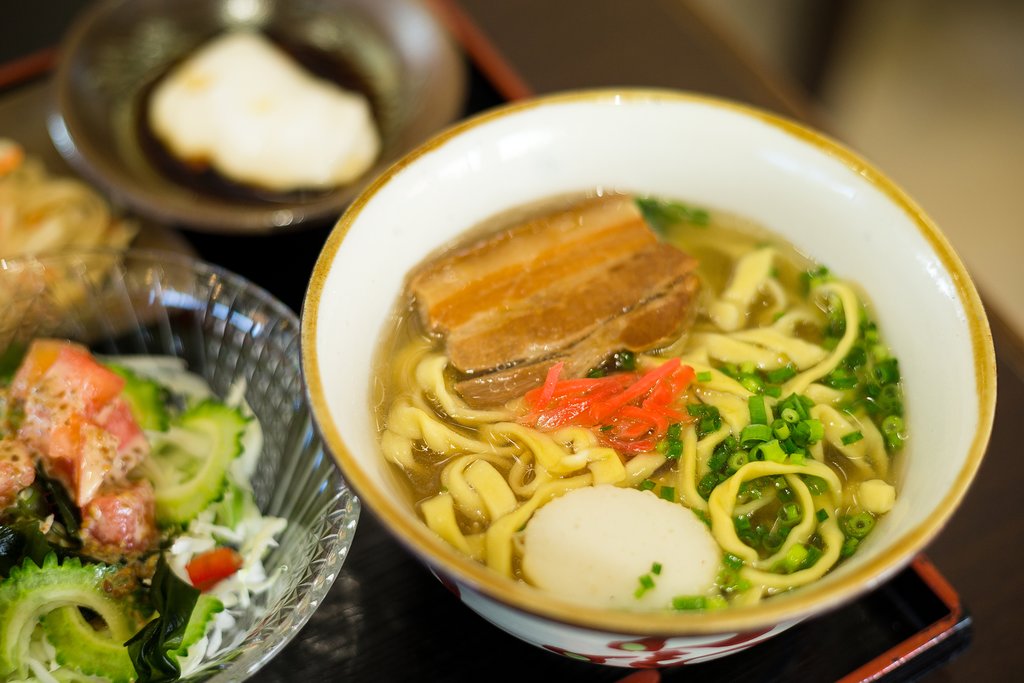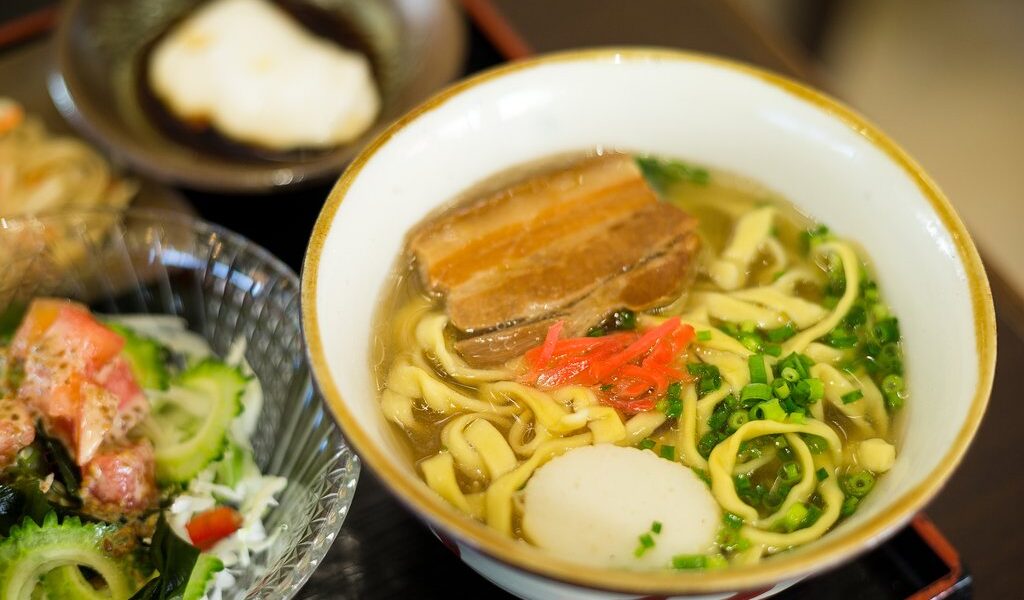
The sunny, laid-back island of Okinawa is not just a tropical paradise: it’s also a foodie heaven with its own unique set of flavors and a famously healthy diet. Whet your palate with this guide to some of the island’s classic dishes, and learn where you can try them.
Okinawa, a captivating island prefecture of Japan, holds culinary secrets that often surprise first-time visitors. The local cuisine of Okinawa is distinctly different from what you might expect to find on the Japanese mainland. This divergence stems from the island’s unique Ryūkyūan heritage, a rich cultural tapestry woven over centuries, as well as historical trade connections that extended far and wide to Southeast Asia and China. These influences have shaped the Okinawan palate and resulted in a delightful and unexpected culinary landscape.
One noticeable difference lies in the consumption of rice. Okinawans traditionally eat rice in significantly smaller amounts compared to their mainland counterparts. Sweet potatoes, a versatile and nutritious root vegetable, traditionally formed the cornerstone of their starch intake. This preference for sweet potatoes over rice is a testament to the island’s agricultural history and the resourcefulness of its people.
Prepare yourself for a culinary adventure, as Okinawan menus are filled with new and exciting delicacies waiting to be discovered. You will encounter succulent fatty pork ribs, prepared in a variety of ways, offering a melt-in-your-mouth experience. Bitter melon, also known as gōyā, with its distinctively bitter taste, is a staple ingredient in many Okinawan dishes. And a dazzling array of local seaweeds, each with its unique flavor and texture, adds a touch of the ocean’s bounty to the local cuisine.
However, American travelers will also find familiar flavors and comforting items on Okinawan menus. The presence of United States military bases in Okinawa has had a profound impact on the island’s culinary landscape. Classic American staples such as ice cream, a beloved treat, and even Spam, a processed meat product, have found their way into the hearts and stomachs of Okinawans, becoming integrated into their daily diet. Moreover, the uniquely Okinawan dish of “taco rice,” a fusion of Mexican and Okinawan flavors, stands as a testament to this cultural exchange.
## The Okinawan Diet: A Path to Longevity
Okinawa is renowned for its exceptional longevity. The island boasts the longest life expectancy in the world, and it is home to over 400 centenarians, individuals who have lived to be over 100 years old. Their remarkable longevity has been attributed, in part, to the traditional Okinawan diet. This dietary pattern emphasizes whole, unprocessed foods and promotes a healthy and balanced lifestyle.
As mentioned earlier, sweet potatoes serve as the staple starch in the Okinawan diet. Okinawans tend to consume predominantly fresh vegetables and legumes, incorporating a vibrant array of colors and nutrients into their meals. They also consume small amounts of fish, a source of omega-3 fatty acids, and meat, prioritizing lean protein sources.
In recent years, the Okinawan diet has undergone some evolution, incorporating international influences and embracing new culinary trends. The introduction of food items like Spam reflects this adaptation to changing tastes and availability. Mainland Japanese cuisine has also exerted a significant influence, with dishes and ingredients from the mainland gradually finding their way into Okinawan homes and restaurants. _Mozuku_, a stringy, locally harvested seaweed with a unique texture, is now often transformed into tempura, a light and crispy deep-fried delicacy. Furthermore, rice and noodles have gradually gained popularity, slowly replacing sweet potatoes as a primary source of carbohydrates. Despite these changes, you can still find those colorful tubers incorporated into various dishes, from side dishes to desserts like ice cream, showcasing their enduring appeal.
## Exploring Local Specialties: A Culinary Adventure
Okinawa offers an abundance of familiar Japanese foods, with convenience stores, known as _conbini_, conveniently located on almost every corner. These stores sell a wide range of ready-to-eat items, including rice balls and bento boxes, catering to busy individuals. However, traditional Okinawan cuisine has its own distinct identity, characterized by iconic dishes that reflect the island’s unique cultural heritage. No trip to the islands is complete without embarking on a tantalizing taste tour, sampling the local specialties and immersing yourself in the Okinawan culinary experience.
**Gōyā champurū:** This dish, often hailed as Okinawa’s signature dish, is a ubiquitous stir-fry featuring bitter gourd, known locally as gōyā. The light green, bumpy-skinned gourd possesses a distinctly bitter taste, as its name suggests. However, this bitterness is artfully balanced with other savory elements, creating a harmonious blend of flavors. The gōyā is hollowed out, sliced into half-rounds, and stir-fried with scrambled egg, fermented island tofu (a local variety of tofu), dried bonito flakes, and pork belly. While pork belly is the traditional ingredient, Spam is often used as a convenient and readily available substitute. White rice is typically served alongside the dish, further mitigating the bitterness of the gourd and adding a touch of sweetness, making it a truly tasty local specialty.
**Soki soba:** On mainland Japan, the term “soba” generally refers to buckwheat noodles. However, in Okinawa, soba takes on a different meaning, referring to thick, udon-style noodles. These hearty noodles are cooked in a clear and flavorful broth made from pork and bonito, resulting in a deeply satisfying culinary experience. The noodles are usually topped with generous chunks of barbecued pork ribs, known as soki, adding a rich and savory element to the dish. A dash of pickled ginger provides a refreshing and zesty counterpoint to the richness of the pork. Soki soba is a simple yet substantial dish, widely regarded as Okinawa’s meatiest meal.
**Taco rice:** This quirky and innovative cross-cultural dish perfectly embodies Okinawa’s mixed influences. After the United States emerged victorious in the Battle of Okinawa, the island became home to thousands of American military personnel. These personnel brought their tastes from home, including a fondness for Mexican food. Okinawans, ever adaptable and innovative, embraced the flavors of Mexico and made the taco their own. They ingeniously swapped the traditional taco shell for a mound of fluffy white rice, creating a new and unique culinary creation. You’ll find this fast-food standard served virtually everywhere in Okinawa, from humble street stalls to upscale restaurants.
**Jushi:** This popular and comforting side dish consists of seasoned rice, carefully prepared and infused with local flavors. The rice is steamed together with seaweed, pork, and vegetables, allowing the flavors to meld and create a harmonious blend. It is then served in a delicate broth made from sweet rice wine and soy sauce, adding a touch of sweetness and umami to the dish.
**Mozuku:** Sushi enthusiasts may be familiar with _nori_, the dried seaweed used in California rolls and other sushi preparations. However, Okinawa boasts a wide variety of edible algae beyond nori, offering a fascinating exploration of the ocean’s bounty. Mozuku, an old Okinawan standby, is a sticky, wiry seaweed that is often served as a refreshing side dish with sweetened vinegar. However, if the slimy texture is too much for your liking, you can also enjoy it deep-fried as tempura, offering a crispy and satisfying alternative. Alternatively, you can find it served in a comforting bowl of udon noodles, adding a unique textural element to the dish.
**Umibudō:** These remarkable algae resemble tiny bunches of grapes, hence their evocative name, which translates to “sea grapes.” Also known as green caviar, this singular seaweed offers a burst of briny flavor and a delightful pop in your mouth. It can be enjoyed as a standalone dish, allowing you to fully appreciate its unique characteristics. Alternatively, you can try it as a topping on a bowl of sashimi and rice at one of Okinawa’s many local _izakaya_, or gastropubs, enhancing the dish with its unique texture and flavor. Due to its delicate nature and inability to travel well, umibudō is a rare and precious treat to be savored in Okinawa.
**Shikwasa:** This tart little citrus fruit plays a versatile role in Okinawan cuisine. It usually appears in refreshing juices or as a bright and zesty garnish, adding a touch of acidity to various dishes. It’s also a popular ingredient in sauces, jellies, and fizzy drinks, lending its unique flavor profile to a wide range of culinary creations. On hot, balmy afternoons, squeezed shikwasa juice is a classic Okinawan refresher, providing a revitalizing and thirst-quenching experience.
**Okinawan brown sugar:** Island dishes such as braised pork ribs (rafute), simmered fish, and noodle broths are often sweetened with _kokuto_, or Okinawan brown sugar. This unique and flavorful sweetener is minimally processed and made by gradually boiling down sugarcane juice, retaining valuable minerals from the raw sugarcane. The result is a complex and nuanced sweetness that enhances the flavors of the dishes it graces.
**Awamori:** Okinawa’s local firewater is a potent distilled beverage made from long-grained rice. The distillation process results in a powerful drink with an alcohol content ranging from 30% to 40%. Traditionally, awamori is enjoyed on the rocks, allowing its full flavor to be appreciated. It is also commonly mixed with water, allowing drinkers to adjust the strength to their liking. In bars and restaurants throughout Okinawa, awamori is typically served with a carafe of water, encouraging patrons to dilute it as much or as little as they prefer. _Kampai_! (Cheers!)
## Where to Dine: Exploring Okinawa’s Culinary Hotspots
In Motobu, a charming town in northeastern Okinawa, you can embark on a culinary pilgrimage to Okinawan noodles on the street affectionately nicknamed “Soba Road.” This street is home to dozens of mouth-watering soba shops, each offering its own unique interpretation of this beloved dish. After indulging in a satisfying bowl of soba, head west on Route 84 in the direction of Okinawa’s famous Churaumi Aquarium, where you can marvel at the resident whale sharks and other fascinating marine creatures.
In Naha, the bustling capital city of Okinawa, Soba stalwart Shuri Soba is a must-visit destination for soba enthusiasts. This popular restaurant almost always has a line out the door, a testament to its exceptional quality and reputation. However, the line moves quickly, and the wait is typically not long. If you’re eager to sample a wide variety of Okinawan specialties, venture into the cross-streets and alleys along the main boulevard of Kokusai-dōri. This vibrant area is teeming with restaurants catering to visitors, offering a diverse range of Okinawan culinary delights. At Yūnangi, you can immerse yourself in a classic _izakaya_ experience, enjoying a convivial atmosphere and a wide selection of local dishes. The illustrated English menu is an added bonus for international visitors. For a truly unforgettable culinary experience, indulge in a multi-course feast of Okinawan culinary hits at Nuchigafu, an Okinawan teahouse that has been transformed into a chic and stylish restaurant.
For budget-conscious travelers, the second floor of Makishi Public Market offers a treasure trove of tasty and authentic Okinawan, Japanese, and Chinese meals served up in a bustling food court atmosphere.
B-1454

